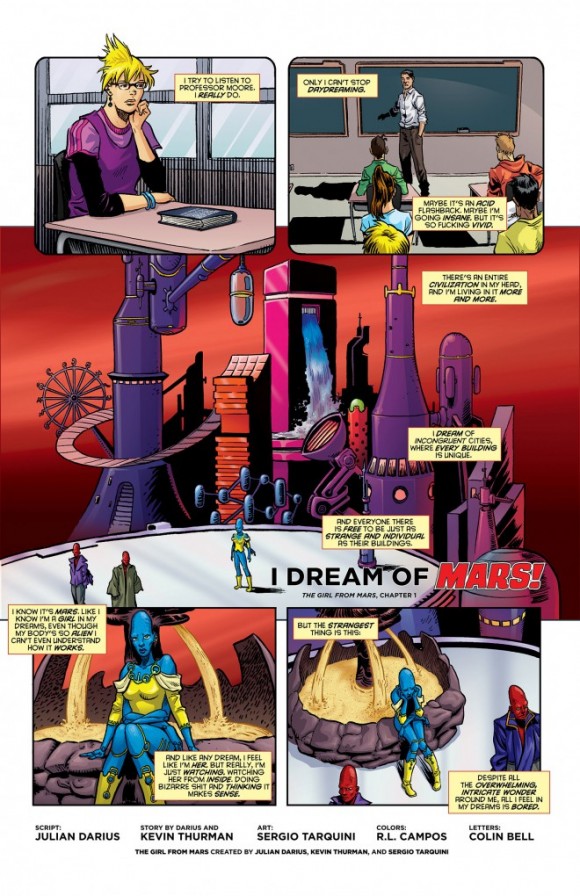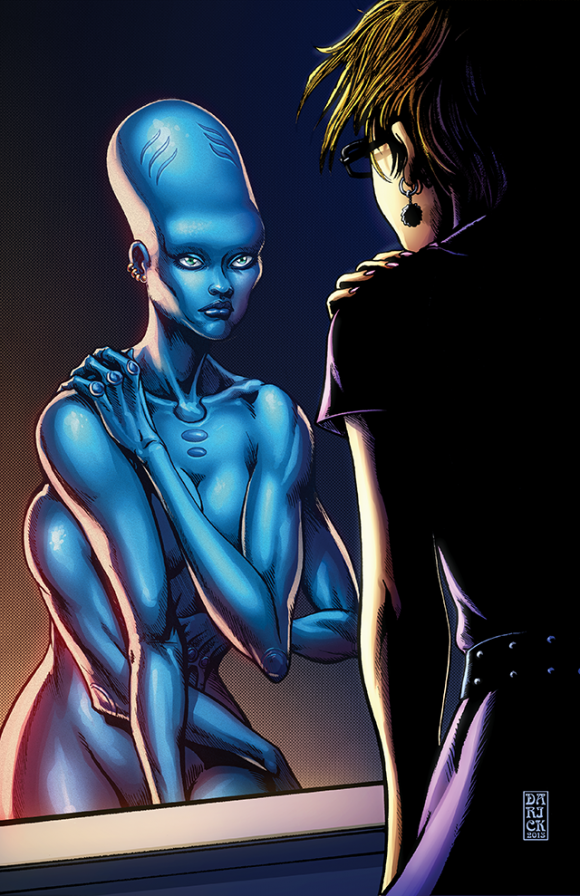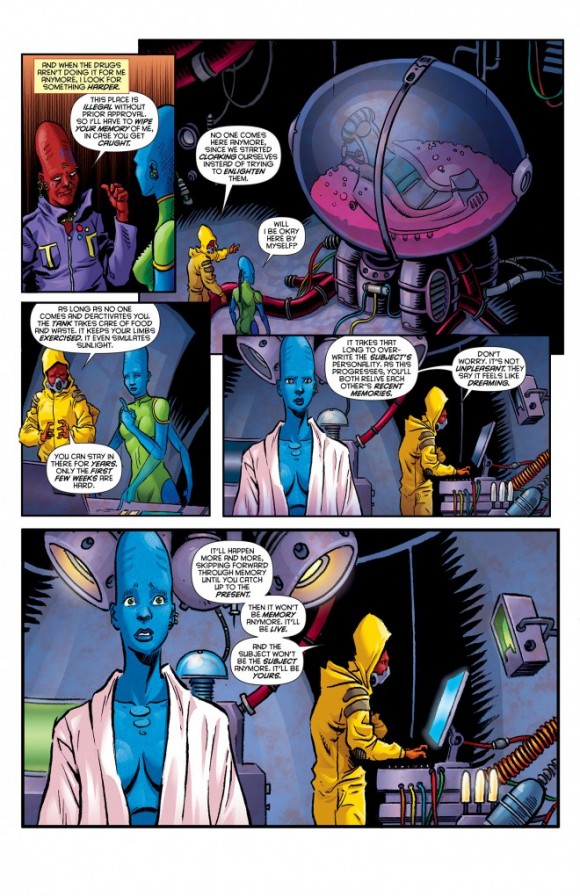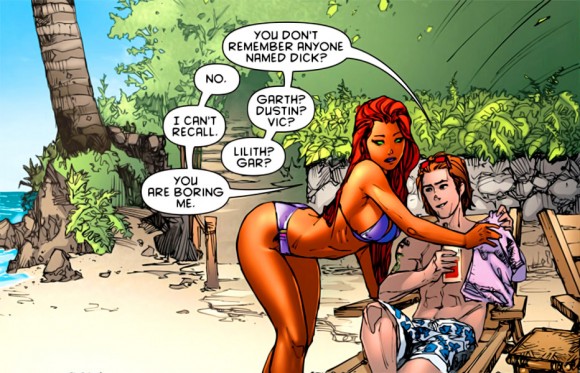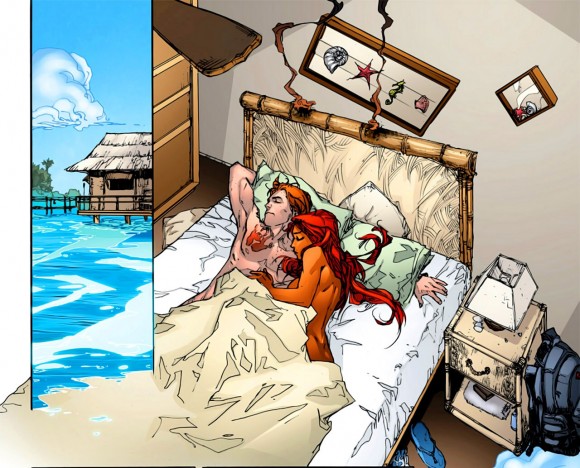This essay by the founder of Sequart started as the answer to a pretty basic question about the sexually graphic nature of his Kickstarter-funded Martian Comics.
Dan here: Personally, I’m not at all offended by graphic depictions of sex among consenting adults, Earth-bound or extraterrestrial. But many are and sex, as anywhere, is a hot-button issue in the comicsphere.
So when I saw this image (NSFW), I just knew that not everybody would see it the same way. So when I interviewed Julian as the funding was in its final hours — it was successful, by the way — I asked:
From what I’ve seen, the book is sexually frank and fairly graphic. There are inevitably going to be people who will accuse you of being exploitative. How do you address that?
And his answer was so lengthy and thoughtful, it made sense to me to publish it in its entirety as its own opinion piece.
So here’s Julian Darius:
I’d personally agree with the term “sexually frank.” I strongly disagree that it’s “graphic” in this respect, except in that it contains images at all. But then my idea of what’s graphic may well differ from others.
I want to take this question seriously and answer fully; it’s a good and important question. But let’s first establish what we’re talking about: bare breasts in the Mars sequence and a one-page scene depicting Martian sexuality. There’s also a single caption on Earth referencing oral sex.
For the record, most of “The Girl from Mars” takes place on Earth, so the sexuality of the depiction of Mars isn’t such an issue in later chapters. It’s not like the second chapter has our Earth girl decide to get naked. This isn’t Little Annie Fanny. The fact that humans have sex won’t be ignored — nor should it be. But it’s not a major component of “The Girl from Mars.”
What you’re seeing in the first chapter is there for a variety of reasons. Obviously, that first chapter juxtaposes Izzy’s life on Earth with her “counterpart” on Mars, and it’s the similarities and the differences between the two — and the two girls’ response to these surroundings — that drive much of the chapter. Mars is presented as a place of great technological wonder and social openness. Also, our Martian is getting into a tank of goo, and I didn’t think a wetsuit made a lot of sense in a non-repressed culture. So yes, our Martian is bare-breasted at times, but no one’s staring at her breasts; it’s not an issue on Mars, any more than body augmentation is, and that fact is important to the story. And while anyone’s free to criticize the titillation of the presentation, it’s important, because it’s a visual emblem of this Martian openness. I don’t think you can effectively depict a truly open society but then be a prude visually (as has too often been the case).
The one-page scene exploring sex on Mars is important because it’s one way of many that our Martian character tries to connect with people or to feel something. That’s made super explicit by the captions. And it doesn’t work: sex by itself feels hollow and empty to her. So I think the effect of this, while not without a titillating element, is to present sex as part of life, to explore how sex is treated on Mars (it’s not a big deal), and to show that sex isn’t an answer to the emptiness we feel.
I think that’s an important distinction, because when you usually see sex in comics and movies, it’s often presented as a kind of glorious moment. Condoms don’t fall off; people aren’t awkward. It’s presented in a very glorified way. And I think this contributes to sex addiction, and more generally to how many of us go looking for meaning in sex or new sexual partners, as if this is the panacea that will finally make us happy. This presentation does explore sex on Mars — which is part of life — but it doesn’t present sex as the be-all-and-end-all, or as an emblem of a male character’s success, or anything remotely like that.
All of this is also important because we’re riffing on sci-fi tropes. If you look at those planetary romances, they’re filled with this stuff. Manly man goes to alien planet, gets the hot alien princess. Sexuality has always been a part of these stories. You have Dejah Thoris in the John Carter of Mars/Barsoom stories. Captain Kirk’s always watching some green girl dance, when he’s not romancing attractive alien girls — although the sex was off-screen. This has been part of the appeal of adventure sci-fi for a long time, and I think that, on a deep psychological level, this sexual fantasy is intricately linked to the fantasy of alien wonder, or of taking a raygun and saving an alien planet.
However we parse those sexual depictions, they are not incidental. They are not some unrelated add-on to the story. They reflect in a deep way the real appeal of these adventure tales. And yes, a lot of those tales were sexist, imperialist, etc. Indisputably. But this is part of the genre’s history, and if we’re riffing on that history, and on how an advanced civilization on Mars tickles our brain, I think it’s wrong to ignore the fact that that this brain buzz has almost always been connected with how a land of sexual possibility titillates our brains and sparks our imaginations.
So without pulling a Tarantino and saying “we’re riffing on these old tropes, so it’s OK no matter what,” we are riffing on those tropes, but we’re going further and recasting these tropes as something sex-positive and actually mature and adult. We’re asking real questions about sex and whether this kind of sexual bounty or possibility is really a cure for our civilized malaise — which is obviously what that alien-planet-of-wonder-and-sex trope is really all about.
That caption about oral sex is actually really important to me too. I don’t think the effect is to say “Ha! Izzy’s sexually active!” I don’t think it’s salacious at all. Of course, the sex isn’t depicted. There’s no slut-shaming at work here, nor a celebration of her sexual activity. Instead, Izzy’s simply expressing how she hasn’t found fulfillment through sexual encounters with college boys at drunken parties. She’s not afraid of sex, or ashamed she’s had it.
But she’s expressing how these casual encounters, which have been kind of one-way in favor of these men, hasn’t fulfilled her. I think that’s actually very empowering. It’s about how these encounters make her feel. And I think we often engage in sex to feel something, to feel connected with someone, or just to feel alive or happy. But it can be hollow too.
What Izzy’s describing is some pretty hollow sex, and she’s just recognizing its hollowness, which is a very advanced, introspective, self-examining thing to do. And there’s the implication that she’s performed oral sex because these men wanted it, and because it’s come to be kind of expected and pretty casual in our society, especially among her age group. I think that’s an accurate depiction. And it’s gendered, and it’s not equal, and it’s about a lot of complex things. And I think this caption acknowledges all of this.
But again, it’s part of her ruminations, as she searches for meaning. The caption doesn’t pretend humans don’t have sex or that blowjobs aren’t commonplace in this setting. But it also doesn’t pretend meaningless sex is an answer for Izzy, which is who it’s focused on. And I think, despite the character’s depression, that this is actually a very healthy, matter-of-fact, realistic presentation. One that’s frank, as you say. One that’s rarely represented in art, but that’s very important to recognize and address.
Of course, Izzy’s experience with college sex also echoes her alter ego’s, who also doesn’t find meaning or real happiness in sex. Although, Mars being Mars, the exploration of Martian sex is a little more graphic and actually shown. But again, I think the attitude towards sex here is actually pretty healthy, and I think it’s important to acknowledge, if we’re going to explore our current Western malaise, or how Izzy could be disaffected despite such affluence (including going to an American university) and unparalleled human technology.
While we’re on the subject of gendered depictions in the comic, I do want to point out a couple other things. One is that (collaborator) Kevin Thurman and I decided that Izzy shouldn’t be a skinny supermodel. She’s not obese, but she’s certainly not the body type we’re used to seeing in comics. She’s very cute, but she’s got a pretty realistic body, and that was very important to us.
This contrasts with her Martian equivalent, who’s maybe more stereotypical, despite being an alien with a long head and four arms. I think that’s so weird — and so counter-cultural — when you think about it. You have this realistic girl dreaming of being this more stereotypical “hot” girl, and she dreams of this alter ego as impossibly alien. The perfect other body is foreign to her and so unattainable that it lives on Mars.
I find that so evocative and fascinating and resonant and even potentially painful to think about. Yet this Martian alter ego retains certain personality traits, such as being bored, almost as if Izzy can’t even dream of being otherwise — as if she’s unconsciously telling herself that having this perfect, impossible alien body wouldn’t make her happy. I think this is some pretty deep stuff. You can say that it has its cake and eats it too; it gets to present a sexy alien body, while also subtly addressing body image issues. That’s fair. But I think addressing this dynamic is a lot truer to how depictions of how female bodies work in that first chapter than simply noting there are breasts, or that sex exists on Mars.
Another thing I’d like to mention is that, although the rest of the story doesn’t have the same level of nudity or of sex (we’re talking about one page!), the next chapter by necessity has to carry forward this theme. Every chapter is different, but you can’t just ignore or drop a theme like that. Also, while this Martian consciousness is adapting to human life, you’re going to see her go to college parties. There’s a lot of alcohol and sex in this setting, and we had to negotiate that.
If we were really “exploitative,” we could easily have had this Martian character, now in a human body, having lots of sex with humans. You could totally justify it. She’s on vacation on Earth, and she’s looking for new experiences, and having sex with aliens in an alien body probably qualifies. Now, I don’t think there’d be anything wrong with such a story. But if you do that, you’re sort of starting down a path, and pretty soon you’re doing a kind of sexual odyssey thing. Which again, is fine. But it wasn’t the sort of story Kevin and I wanted to tell, and it’s not a good vehicle for the issues we wanted to address.
The more Kevin and I talked it out, the more we realized that it was far more interesting if she wasn’t much interested in sex on Earth at all. After all, she’d already tried that on Mars. We’d already shown that. It didn’t fill the emotional void. And these human bodies aren’t remotely as interesting. She wasn’t on Earth for that; she’s there to connect with people, to experience something new.
While Kevin and I were talking this out, the critical fallout from the 2011 DC Comics relaunch was going on. (Yes, that’s how long we’ve been working on this.) Kevin and I were both troubled in particular by the depiction of Starfire, who I assume was intended to be a sex-positive feminist portrayal, but who in fact was a kind of male fantasy: this impossibly skinny, big-breasted, sexy alien girl who will sleep with anybody and whose species can’t even remember which humans she’s had sex with. That depiction perpetuates the virgin/whore dichotomy. Basically, in trying to show that a female character didn’t have to be chaste, the creators flipped to the other end of the spectrum, and the result was this total male fantasy of a perfect, gorgeous sex object, with whom sex was by definition anonymous and inconsequential.
Now, if that’s what the creators were trying to do, I happen to think that’s fine. It’s actually kind of creative to invent an alien sex girl who’s genetically incapable of distinguishing between her partners. I could see that working as a softcore exploitation comic, and you could do it artistically, like a slightly more risque Jonni Future. But this was being offered up as a pro-female depiction, in a comic designed as an entry point for a wide general audience, as part of an initiative that was said to be trying to reach out to female readers. This character simply didn’t work as that. In fact, it was a pretty catastrophic failure, in this context. I was glad to see critics point this out, and I added my own voice to those doing so.
As Kevin and I tossed thoughts around, I realized that what really bothered me about this version of Starfire wasn’t that this softcore idea had been put into a comic where it not only didn’t belong but where it worked against to that comic’s supposed agenda. That was a catastrophic creative misjudgment. But what bothered me more was this underlying idea that if a woman is sexually “liberated,” she’s got to have sex with you. Because that’s sadly how a lot of men think. It’s like translating the virgin/whore dichotomy into “you’re repressed”/”you’ll say yes to me.” Because that’s ultimately what was underlying, for me, this depiction of Starfire: that despite her physical desirability, she’s interested in sex with all men equally, because she literally can’t tell them apart. So she could be a supermodel, but every guy has an equal shot. She doesn’t discriminate because she can’t.
The idea is that a woman who has sex, who doesn’t fear her own body, can’t also discriminate in her partners. Can’t be be “clingy,” or want anything more than anonymous sex. Otherwise, she’s self-loathing and repressed. The mentality is that there’s nothing between these two extremes — despite that everyone, male or female, actually falls between these two.
I’ve seen guys use this kind of thinking, and it’s really ugly. And I think it’s related to how a lot of guys think that, because a woman’s in a sexy outfit, she’s got to be available to them. It’s like their brain is still in this virgin/whore dichotomy, and if a woman’s having sex, she’s got to be having sex with basically anyone. And I think that, while this Starfire depiction was troubling on its face, on a deeper level it exposes this underlying strain of thinking that’s (without putting too fine a point on it) actually pretty dangerous.
So we took all of this contextual discussion and put it in the text, as tersely as possible. In the second chapter, Izzy’s at one of those college parties, and she’s fascinated by the social interaction. She’s there to connect with people, and here these humans are getting together only to get blotto by drinking too much, which ends up disconnecting them. It’s so odd to her. She also can’t quite figure out their humor, which is presented in a way that ties into the sexual themes left over from the first chapter and ends up becoming an important plot point, tying everything together.
Anyway, one of these drunken guys hits on her, in a really crude way. Of course, she’s not interested, and she’s got a single caption explaining all the stuff I’ve just written about, from Kevin and my long discussion, explaining why she logically wouldn’t be interested in this. (That’s how thought-out this comic is; one sentence might have an hours-long discussion behind it.) This drunk guy presses his case, saying he thought she was liberated, playing this by-now-old card. And she shuts him down, saying that just because she likes dick doesn’t mean he could interest her in his.
To me, that’s a kind of quintessential statement: that just because I’m not sexually repressed doesn’t mean I have to say yes to you. Or anyone. It doesn’t mean I have to be undiscriminating. It’s a statement about her own power, her own intelligence, her own confidence, her own agency, and her own matter-of-fact refusal to be defined by others’ terms. It’s a clear line in the sand that this character isn’t like that Starfire depiction. And it was important to us to do, not only for its own sake but also because we didn’t want people to misinterpret that first chapter.
I think it’s a key moment. Because delivering this kind of message isn’t what this comic is about. It’s not a preachy or dogmatic comic. This isn’t a comic that’s being sold on the basis of having a female protagonist who’s a counter-balance to presentations like Starfire. I think that’s great, and I fully support that, and the industry very much needs that, but that’s not what this is.
At the same time, I think a cursory reading of the first chapter of Martian Comics makes it very clear that this isn’t some silly sexploitation comic. Yes, it’s got some titillating elements in its first chapter, and addresses sex as part of asking larger issues, but that isn’t about any of that. So it’s this in-between thing, which I think is what I’d most like to read anyway: thoughtful comics that can present sex and sexuality and even titillating images as part of a fuller picture, but that aren’t ghetto-ized as “that feminist comic” or whatever.
Izzy’s also Hispanic, and that’s a part of the story, but it’s not “that Hispanic comic.” It’s not the titillating sexploitation comic. It’s not the feminist comic. It’s not the Hispanic comic. It’s not “that comic starring a Hispanic girl.” It can do all of these things without being about them. And I hope that’s actually where we’re headed, once the problematic dominant strains and their self-conscious responses settle down.
Look, I wrote the script to that first chapter, and I can’t imagine anyone reading it and thinking this is just wank material. As a writer, you can’t expect readers to get all of the deeper meanings you intend, or to catch the resonances, but you certainly hope people intuit in the right directions. I mean, it’s called “I Dream of Mars!” It’s obviously playing with this whole pulp tradition and the fantasy of it. And I can’t imagine anyone missing the obvious intelligence of the piece, or being confused because “it seems smart but … boobies!” But I’m biased because I’m the writer. So just in case anyone’s misread, I thought this scene in Chapter 2 was a good way of saying that, if you enjoyed that nudity and brief sex scene, that’s totally fine, but don’t think this character is a slut because of it, or that her sexual choices define her, or anything like that. If that’s what you think, our main character sets you straight along with that drunk guy.
And I think that’s a pretty counter-cultural act. I mean, it’s one thing to preach “don’t see women in this way.” That’s fine, but it’s going to get marginalized as a feminist comic, or a message comic, and it’s not going to appeal much beyond the already converted. I think it’s actually a lot more rebellious — and maybe even effective — to include nudity and sex as an aspect of your story, without judgment, while making sure any aroused brains aren’t connecting this to this ugly strain of thought.
Okay, so that’s the evidence — all of the sexual stuff in this first issue — and how I personally understand it. That’s not solely about my intent; I’m not just saying “I’m a good guy, and I’m aware of these issues, so give me a pass.” I’m talking about what’s there on the page and in the text; these themes and dynamics are in the text themselves, whether one chooses to see them or to simply focus on the fact that there are — egad! — bare breasts.
I’m not saying there aren’t issues there, or nuances and implications to discuss and work out to any depiction, especially sexual ones. But there’s a lot more going on than nudity or sex and the fact that straight men will likely enjoy seeing them. In sexploitation, breasts are just breasts. In good art, they — like everything in a story — are considered and function as part of a whole, interwoven with multiple themes and subthemes. That’s how art works, and one of the hallmarks of bad criticism is to simply focus on what’s present in a story, rather than how it functions.
In fact, outside of comics, it hasn’t been OK to object to what’s present in the story since the art for art’s sake movement. And objecting to something just because it’s titillating would also apply to the vast bulk of classic art and literature. The Bible contains pornographic poetry, of course. There’s a real need for a mature comics criticism that doesn’t make these kinds of errors, which you don’t see with most other media.
Of course, that doesn’t mean we shouldn’t object to the way women are sexualized in comics generally. That’s a very real scandal. To me, that argument is basically analogous to the objection to the superhero genre being so dominant. In other words, the problem isn’t that these hypersexualized depictions exist, or that men are reading them, or even that someone made a super-hero comic with them. There’s a place for all of that, and the male desire to see these images is probably biological.
No, the problem is that these images are so dominant that they’re now everywhere in comics. And this problem is certainly compounded when you have things like rape being depicted in an entertaining or alluring way. But while we rightly condemn this, I think we have to be responsible enough not to go that extra step and also be seen as condemning all titillating or even objectified depictions — which isn’t only anti-art and anti-comics but is also likely to alienate people, rather than raise awareness of a legitimate problem.
Although I hasten to point out that any such critical errors are of an entirely different sort from the often violent, reactionary response such criticisms get — which includes the routine receipt of rape threats for women brave enough to state their opinion. You can pardon an artistic or intellectual error, but that kind of behavior is inexcusable and intolerable.
And while I do wish comics criticism would mature a little, it’s obvious that comics culture has a lot more maturing to do. Because part of having a culture of serious comics criticism is having fans who don’t react with such hostility to the slightest criticism of their favorite comics. Which suggests a kind of insecurity that their comics — or even all comics — somehow couldn’t withstand the scathing observations of a critic sharing his or her considered opinions.
I’m a fan of classic James Bond movies, but you’d have to be nuts not to acknowledge they’re sexist. No one thinks that invalidates those movies or invalidates you if you like them. Of course, Bond girls are sex objects, and the films are straight male fantasies, but that doesn’t mean we can’t admit this and that we like them. Nor does being sexist mean that they don’t have a lot of other stuff going on in them that’s interesting.
Comics criticism might have to get a little better, but comics fans have really got to grow up and stop this reactionary nonsense. Interestingly, both are at their worst when they equivocate between titillation and trash.

